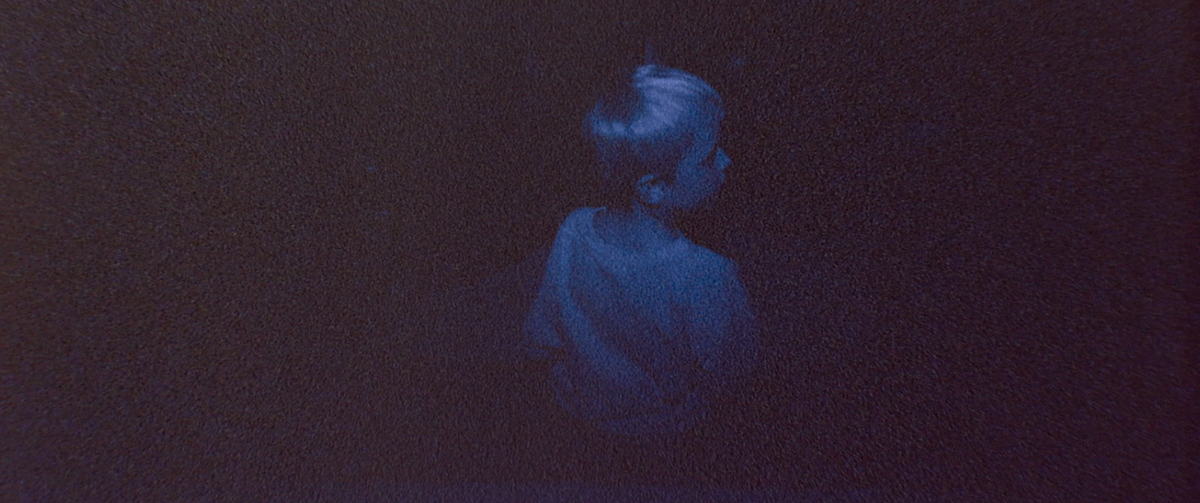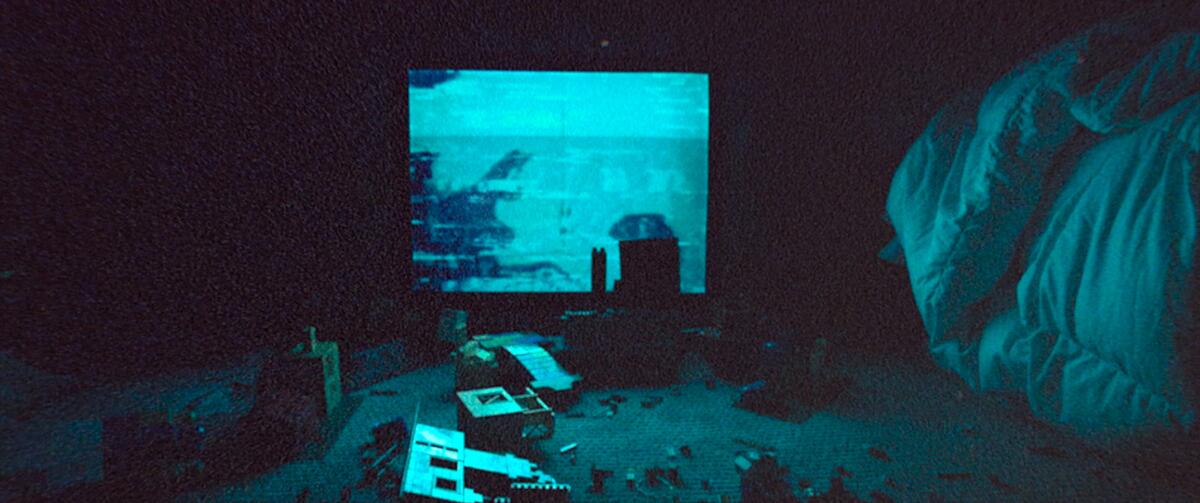‘Skinamarink’: Inside the ‘polarizing’ $15,000 horror movie that became a viral hit

- Share via
“Skinamarink,” the runaway success story of the moment, is at once the stuff of literal nightmares and every indie filmmaker’s dream: a $15,000 chiller that’s earned $1.8 million in theaters in a matter of weeks. And, love it or hate it, polarizing reactions have made writer-director Kyle Edward Ball’s experimental debut feature — in which two young siblings wake up in the middle of the night to find their father gone, the doors and windows missing and a malevolent entity in the shadows — cinema’s latest word-of-mouth sensation.
Crowdfunded and filmed over seven days in Ball’s childhood home, the film’s unlikely journey to box office success has not been without stumbles. It premiered last summer at film festivals only to be leaked online in the fall, leaving Ball “panicked and terrified,” then was discovered and hailed on TikTok, Reddit and other social media platforms as one of the scariest movies ever made. In a strategic move, IFC Films shifted its theatrical release from October to January, and the outsize reactions to the film have only strengthened “Skinamarink‘s” must-see mystique. (It’s also streaming now on Shudder.)
It’s no wonder that the Edmonton, Alberta-based Ball, in Los Angeles for the first time this week to screen his viral horror hit, is still processing the roller coaster ride that landed him here. “Everything that a filmmaker dreams that would happen to them, except for winning an Oscar, has happened to me in the span of just a couple of months,” he said ahead of a special screening Thursday night at the Ace Hotel.
Still, the fervor of “Skinamarink” fandom has led Ball to scale back his social media presence. “I had to delete my Instagram because I was getting so many messages. Someone got a ‘Skinamarink’ tattoo, and I was like, ‘Oh, my God.’ Then I took a step back and I remembered, this is this person’s relationship to something you did, but it’s not you. They liked the movie. They might not even know your name.”
An immersive horror movie that demands to be seen in a theater, director Kyle Edward Ball’s ‘Skinamarink’ drops the viewer into a disorienting exploration of a darkened house.
Good luck to the Hollywood execs who are surely scrambling to replicate the singular “Skinamarink” phenomenon, though. Unlike its genre forebears (think microbudget megahits “The Blair Witch Project” or “Paranormal Activity”), “Skinamarink” takes an immersive approach less concerned with plot turns than avant-garde sensory evocation. At 1 hour and 40 minutes, its grainy long takes and shadowy images of hallways, rooms and staticky televisions reward patient moviegoers with a portal to their earliest childhood nightmares as seen from the perspective of 4-year-old Kevin (played by Lucas Paul) and his 6-year-old sister, Kaylee (Dali Rose Tetreault), characters inspired by Ball and his own sister.
His tips for making a viral horror hit for just $15,000? Don’t be mean. Plan preproduction “like you’re traversing Everest.” Find like-minded collaborators. Crowdfund using platforms like Seed&Spark. And most of all: “Make the movie you want to make, not the movie that you think others want to see.”
“Sometimes the price that you pay in making a polarizing movie is that that’s the only way you can get the super personal in there,” said Ball. “People send me incredibly personal [messages], and it’s been amazing. And if I made something that would appeal to a broader audience, I’d maybe be losing some of that.”

Many fans find that “Skinamarink” taps into their own deeply buried childhood memories and fears. Is this the effect you hoped it would have?
I always hoped that it would have somewhat of that effect, but I wasn’t expecting it to be this extreme, particularly with the childhood feelings and memories. I did intend it to provoke that, but I didn’t think people would be as receptive to it, because to me it was just my little movie that I was making.
You list among your influences experimental filmmakers like Maya Deren and Stan Brakhage. Where did your creative spark first come from, and why do you think you gravitate toward horror?
I’ve always loved horror. I was a big fan when I was little of the “Goosebumps” books and “Are You Afraid of the Dark?” and got into more adult horror at a fairly young age. I saw “The Shining” when I was 8, I saw Hitchcock when I was 8, and it spiraled out of there. I started perusing the horror video section of our local video store, Video Town, where my parents were fairly lax on what they’d let me and my sister watch. When I grew up, I got into the masters — Kubrick, Tarkovsky, Ozu, Kurosawa and more experimental people like Maya Deren and Stan Brakhage, but there’s even things you can learn from movies like “Clueless” by Amy Heckerling. I think that movie is unironically a masterpiece and can teach a horror filmmaker something about being tight and concise and clever and not talking down to the audience. If you’re a good filmmaker, you draw from all inspirations, right?
Scare yourself silly this Halloween without leaving the house: Horror buff Jen Yamato picks 10 titles to stream, from the mainstream to the obscure.
“Skinamarink” conjures nightmarish imagery from the perspective of kids waking up in the middle of the night. What kind of dreams did you have as a child, and what kind of dreams do you have now as an adult?
I always dream in color, but I’ve been told a lot of people dream in black and white. Growing up, I had fairly similar dreams to what everyone else had.... I do vividly to this day have a lot of zombie-related dreams. That was a recurring thing ever since I was little. It was always couched in “Night of the Living Dead”-esque scenarios, “28 Days Later”-esque scenarios.
And I seem to have this recurring dream: I live in Edmonton, where we have the West Edmonton Mall — it’s our biggest tourist attraction, and our history with it as a city is kind of complicated because it’s a ridiculous thing, this big mall. Growing up, we rarely visited it because we lived on the opposite end of the city. But it always stuck in my mind. So a lot of my dreams, even into adulthood, are me taking a bus or traveling towards West Edmonton Mall. I don’t know what that’s about. Maybe there’s some sort of late-stage capitalism thing you could analyze. It’s weird.
Your YouTube series ”Bitesized Nightmares,” in which you filmed the nightmare submissions sent in by strangers, was a creative staging ground for scenarios you evoke in “Skinamarink.” What did you learn from that series about the fears that collectively haunt us and how you could convey them cinematically?
This was never really the intention when I started the series, but I would learn what scared people, kind of by accident. Because they’re not directly telling me, “This is what scares me.” It was their subconscious telling them what scared them. All I could do is try to attempt to re-create the feeling of it. So in that weird way, it was an almost textbook case of stumbling upon a sandbox of how to make horror movies. It was also a good secondary sandbox as a way to learn what I’m good at, what I’m not good at, what I like to do as a filmmaker, what I don’t like to do as a filmmaker, how to take criticism, how to take community feedback, how to work with a crew, how to work with amateurs. It was my second film school in a way.

I’m not sure it’s easy for most people to learn how to take criticism.
I’m good at getting feedback from work or even stuff that my ego is completely detached from. The only thing that I’m not good at is flat insults. Some filmmakers I talk to appear so incredibly thick-skinned in comparison to me. But in general in life, I’m incredibly sensitive.... And I’d like to stay a little bit sensitive. I don’t want to become too tough. Because then I won’t continue to make movies like “Skinamarink.”
The film’s trailer went viral, largely thanks to TikTok reactions. How did you process how far and fast the film blew up?
It feels incredibly validating and amazing that you’ve made something special when the air-quote “kids” like it. It also felt like a throughline back to my YouTube channel. A lot of the people who commented on my YouTube channel were Gen Zers, and this is the part of the dream that you want to have happen.... I wanted to respond to every DM, but then after a while it became apparent that that was impossible, because there were so many. I had to do a pinned Tweet saying, “I’m so sorry guys, I can’t respond to every DM.” I’m just one person, right? That was a weird thing too. No one prepares you for stuff like that.
With ‘Malignant,’ ‘M3GAN’ and ‘The Nun 2,’ writer Akela Cooper is the ‘merciless’ new voice of studio horror — and the genre is better for it.
Filmmaker Jane Schoenbrun tweeted their reaction, calling the film “a deeply painful reflection on queer childhood.” Did that resonate with your creative intentions for the film?
First of all, I’m touched that Jane took it that way. I specifically wrote Kevin at 4 years old, and my mindset of 4 years old, where the world was perfect and I wouldn’t necessarily have to worry about — I’m gonna cry — encountering bad stuff. You could say the context of this is before the queer kid encounters the outside world. That was my take on it, and I’m touched that Jane interpreted it as that way for themselves. Outside of that, it’s hard to find a lot of overtly queer stuff in the movie. I’m touched that other queer people and queer filmmakers are interpreting that aspect for themselves. There is a Barbie on the ceiling, so maybe that — you could interpret that. Because a lot of queer little boys like me, we played with Barbies and doll houses.
Are you still interested in how people respond, whether positive, negative or across the spectrum?
Originally I was looking at stuff across the spectrum, but after a while even stuff that was positive I’d read through it and there’d be a little bit of snark hidden in there. I’m a human being. I’ve been trying to gently step away from the reactions. I had to delete my Letterboxd account. I just couldn’t do it anymore.
I’ll look at all the fan art. Because that’s something that isn’t going to overwhelm my senses, and that’s been incredibly rewarding. You know when you have a night and you’re just in your feelings? While I was still taking every DM, someone sent me something they physically painted, and it was the doll house towards the end of the film. And I burst into tears seeing it. I messaged them back like, “That’s the doll house me and my sister played with growing up. Thank you so much.”
- Share via
Watch L.A. Times Today at 7 p.m. on Spectrum News 1 on Channel 1 or live stream on the Spectrum News App. Palos Verdes Peninsula and Orange County viewers can watch on Cox Systems on channel 99.
More to Read
Only good movies
Get the Indie Focus newsletter, Mark Olsen's weekly guide to the world of cinema.
You may occasionally receive promotional content from the Los Angeles Times.















